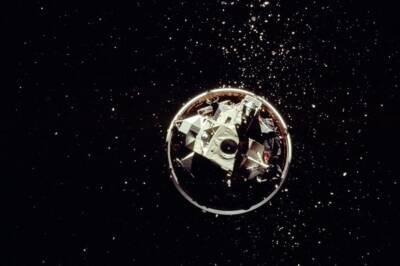The solution to the space debris problem is common sense, as presented here.
CNN reports that outer space is now so crowded with space debris from satellites, orbital missions and other equipment that a collision between two or more of such objects appears imminent.1 Such occurrences will eventually have earth-shaking consequences, unless we can prevent them from multiplying.
 An aerospace engineer at University of Texas is urging the scientific community to take it seriously. It even has a name: deep space traffic. Traffic lanes are now so congested that accidents are bound to happen. If so, then obeying the law of gravity is destined to cause violations of it, the paradox making Isaac Newton an accessory prior to the fact. That calls for deep thought, worthy of a proud, powerful nation governed by a deep state.
An aerospace engineer at University of Texas is urging the scientific community to take it seriously. It even has a name: deep space traffic. Traffic lanes are now so congested that accidents are bound to happen. If so, then obeying the law of gravity is destined to cause violations of it, the paradox making Isaac Newton an accessory prior to the fact. That calls for deep thought, worthy of a proud, powerful nation governed by a deep state.
Yet the solution to the deep space traffic problem requires nothing more than what Thomas Paine or even Sarah Palin would call common sense. So, in the name of science, I offer the following strategies to deal with this dilemma, before it “goes viral” and becomes a global health crisis.
- Put a space cop in every orbital path, armed with lasers, trained to choke-hold astronauts, and authorized to issue $75 million citations for space-speeding, reckless docking, and no alternate side of the asteroid belt parking.
- Install traffic lights on the dark side of the moon. Convert large craters to speed traps. Instagram each and every traffic summons.
- Call a summit meeting of all the planets. To promote inclusiveness, invite Pluto. Explain the situation, and ask for their cooperation, so they can teach all their moons, rings, and stray comets not to cross the Milky Way by themselves, or to go out of the solar system at night.
- Get the public involved! Ask for more volunteers to clean up space litter on long equinox weekends. Place space trash (not to be confused with “sexual trash talking”) in the proper “black gold”2 receptacles, to be recycled as petroleum by-products back on earth.
- Last but not least, lobby Congress to give generous tax breaks to the top 1%, so they can reach the stars and control the flow of traffic, just as they do here. Use the freeway system in Los Angeles as a model for future space colonies3, making orbital gridlock routine, and reduce the level of astro-anomic distress. In time, no one will even notice all of the space debris, and the rainbow will be over, even in the faster than light lane. No clutter, just cremation.
That is the final solution to the human garbage problem. I offer it humbly, as a modest proposal for scientific inquiry and political policy-making, working to make us free. Do it now, without delay, lest the consequences of waiting be too catastrophic to imagine, let alone bear. On earth as in heaven, cleanliness is next to deadliness. So start your rocket launchers, and hurl those phallic suppositories into space, before it’s too late for an enema. And remember, the universe you entomb may be your own.
1 Jackie Wattles, “Why We Don’t Know What Exactly Happened During a Near-Collision in Space,” CNN Business, October 16, 2020. The Texas savant in a questioning mode is Prof. Moriba Jah, who is renowned for his work in the nascent field of ‘space tracking.’
2 So named because of their resemblance to “black holes,” which lost their cluster when hawking them became a regular event, thus entropying their last horizons.
3 NASA has already done that, since the late 1990s. The use of the term ‘colonies’ is no accident, either. Imported smog will be expensive, especially on planets with no atmosphere and/or low escape velocities, but since the penalty for breathing will be quite stiff, that should not be a major obstacle to intergalactic hegemony.
- A Shot in the Park: Immunization in Sports - October 13, 2021
- Reuben Klamer and the Death of a Talisman - October 5, 2021
- The Mistake, aka The Drake - August 13, 2021

